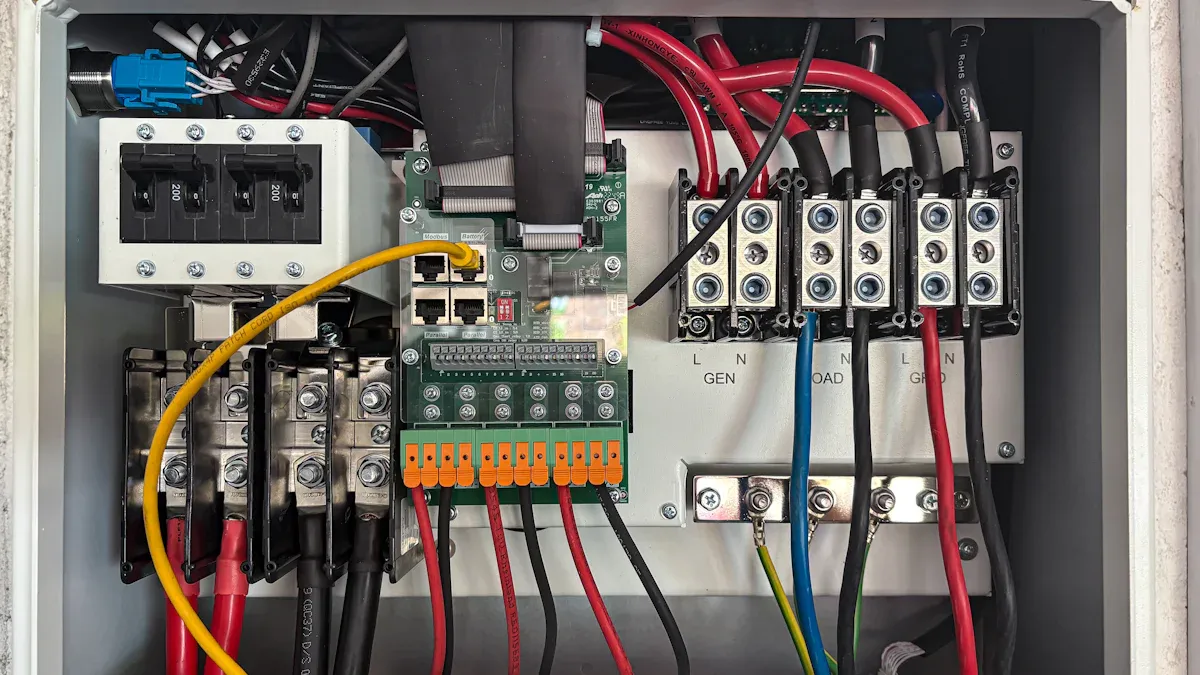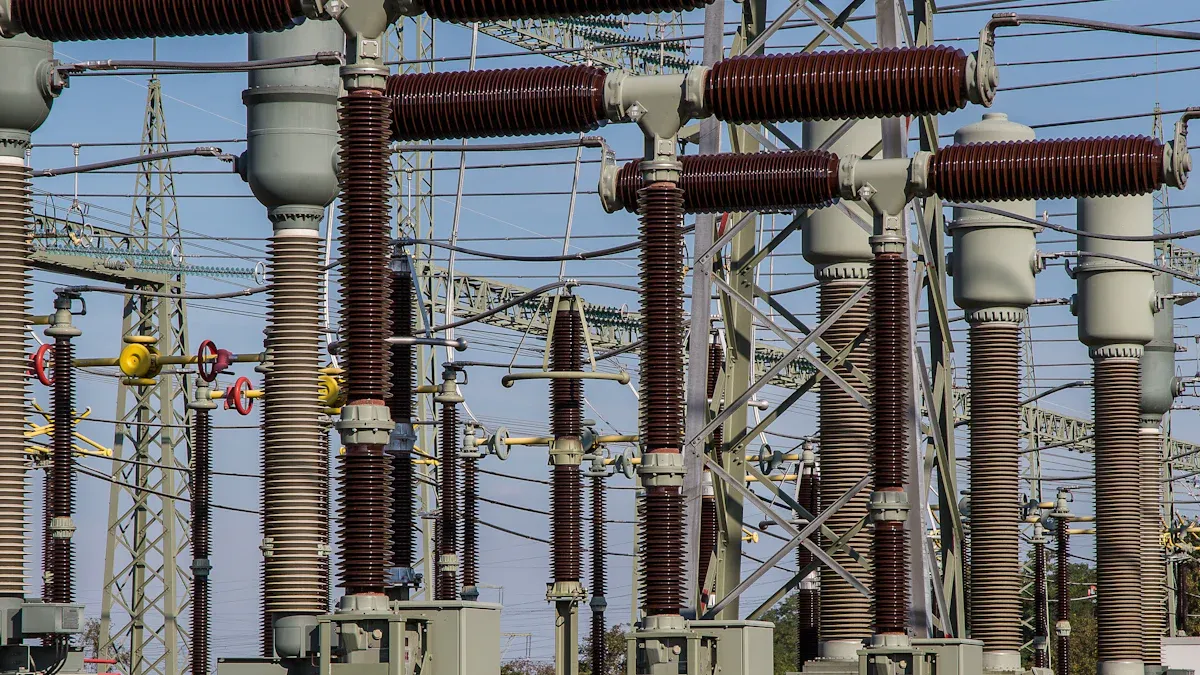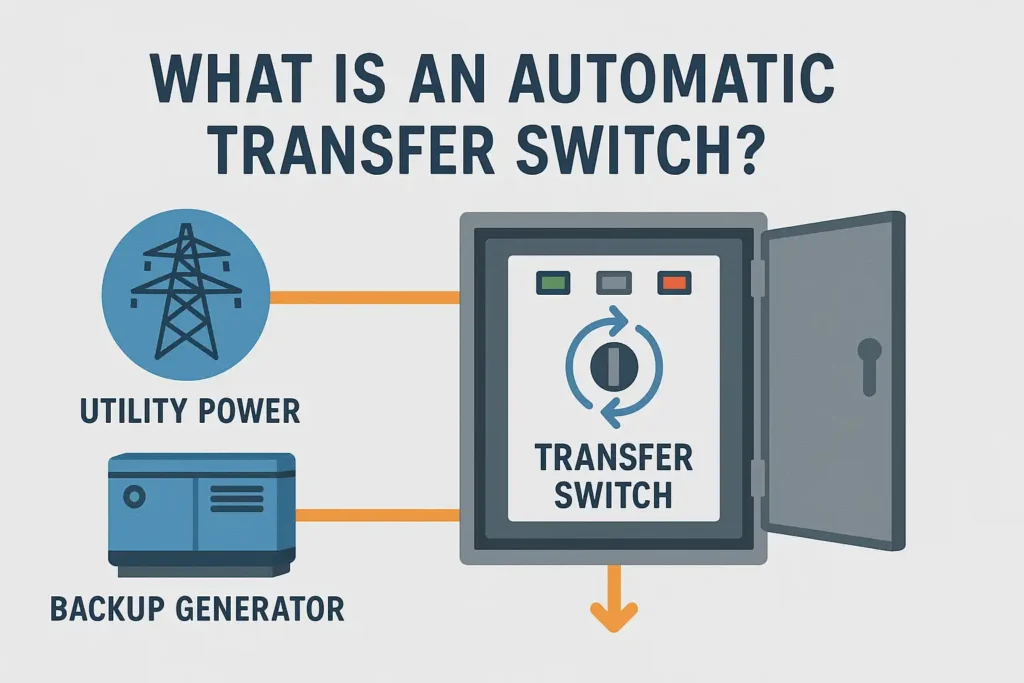An automatic transfer switch notices when your main power stops or is not steady. It quickly moves your electricity to a backup source, like a generator. This keeps your lights and machines working. You use this device to make sure your power is safe and steady. It is very important in places like hospitals and data centers.
| Key Feature | Benefit |
|---|---|
| Fast automatic switching | Keeps your power running without delay |
| Reliable operation | Protects equipment and prevents interruptions |
Key Takeaways
- An automatic transfer switch moves power to backup fast when main power stops. This keeps your lights and machines working with no pause. The switch always checks power quality. It safely switches power sources to protect your equipment from harm and power spikes. There are different types of switches. Some switches cause short power breaks. Others switch power with no break at all. These switches work for homes, hospitals, and data centers. Using an ATS keeps homes safe during blackouts. It helps businesses keep working well. It makes sure places like hospitals always have power. Picking the right automatic transfer switch gives steady power. It means less time without power and better safety for your devices and important jobs.
Automatic Transfer Switch Functions

Power Source Monitoring
You count on an automatic transfer switch to always watch your main power. This device checks the voltage and frequency using special sensors. It looks for problems with your main power source. If the power is not steady or stops, the switch finds out fast. Some systems let you check them from far away. They can also tell you right away if there is a problem. These features help you stop surprise power loss. They keep your equipment working well.
Tip: Many automatic transfer switches now use smart technology, like IoT integration, to make checking your power easier and faster.
Automatic Load Transfer
If your main power stops, you do not need to do anything. The automatic transfer switch does the work for you. It disconnects your equipment from the bad power source. Then it connects your equipment to your backup generator or another power supply. This switch works in just a few seconds, usually between 5 and 10 seconds. Your lights and machines stay on with almost no break. When the main power is good again, the switch moves your load back. This quick action keeps your power on and protects your daily work.
- The switch finds a power problem.
- It tells the backup generator to turn on.
- When the generator is ready, the switch moves the load.
- Your power stays steady and safe.
Safety and Reliability
Safety is very important for any electrical system. An automatic transfer switch stops both power sources from working together. Special parts and designs make sure only one source gives power at a time. This keeps your equipment safe from harm. It also stops dangerous things like short circuits or back-feeding. In places like hospitals and data centers, this is very important. The switch lets you test and check your system often. You can trust your power will work when you need it.
Note: Some switches use a “break before make” way. This means they stop one power source before starting another. This keeps your system safe and follows strict electrical rules.
How an Automatic Transfer Switch Works
Key Components
Inside an automatic transfer switch, you find many important parts. Each part helps keep your power safe and steady. The table below lists the main parts and what they do:
| Component | Role in ATS Operation |
|---|---|
| Transfer switch mechanism | Connects or disconnects power sources to switch between main and backup power. |
| Automatic source sensing devices | Detect power failures by checking voltage, frequency, and phase; start the transfer process. |
| Control circuitry and monitoring systems | Manage switching, show real-time status, and allow advanced features like load prioritization. |
| Power distribution connections | Send power to your lights and machines from the chosen power source. |
| Main control unit | Watches both power sources and controls switching. |
| Power contacts | Make the physical connection between power sources. |
| Voltage sensors | Check power quality and availability. |
| Status indicators | Show you what is happening right now. |
| Protection circuits | Stop damage from electrical faults. |
Tip: Many automatic transfer switches use smart sensors and control units. These help your power stay reliable.
Sensing and Detection
The sensing system checks your power all the time. Sensors and microprocessors watch things like voltage, frequency, and phase. They look for problems such as voltage drops or changes in frequency. If something is wrong, the sensors send data to the control unit. The control unit uses rules to decide if the power is safe.
- The system checks voltage, current, and frequency right away.
- If power is too high, too low, or not steady, the sensors notice fast.
- The control unit gets this data and decides if a switch is needed.
- If there is a problem, the switch moves your load to the backup source to keep your power on.
You may see different sensors in your automatic transfer switch. These include voltage sensors, current sensors, frequency sensors, phase sensors, and temperature sensors at contact points. These sensors help find trouble early and keep your system working well.
Switching Process
The switching process happens in a set order. You do not need to do anything because the system works by itself. Here is how it usually works:
- The switch checks the main power’s voltage and frequency.
- If it finds a problem, the switch starts the transfer steps.
- The system checks if the backup source is ready and matches the needed voltage, frequency, and phase.
- The switch disconnects your load from the main power.
- It connects your load to the backup source.
- When the main power comes back and is steady, the switch moves your load back to it.
This process is fast, often just a few seconds. The automatic transfer switch uses special locks and control logic. Only one power source connects at a time. This stops electrical surges and keeps your equipment safe. Some switches wait a short time before switching to avoid problems from quick power flickers. Sometimes, the switch matches the phase of both sources before moving the load. This helps stop power surges.
Note: The automatic transfer switch keeps your power on and your equipment safe. It switches smoothly and never lets both sources connect at once.
Types of Automatic Transfer Switches
There are different types of automatic transfer switches. Each type switches power in its own way. The table below shows how they are different:
| Type of ATS | Operation Method | Power Interruption | Typical Applications |
|---|---|---|---|
| Open Transition | Break-before-make | Momentary outage (few seconds) | Homes, non-critical lighting |
| Closed Transition | Make-before-break | Nearly seamless (~100 ms) | Hospitals, data centers, UPS systems |
| Delayed Transition | Break-before-make with delay | Delay protects equipment | Large motors, industrial settings |
| Soft Load Transfer | Gradual load ramp-up | Avoids sudden changes | Sensitive electronics, data centers |
Open Transition
Open transition ATS uses break-before-make. It disconnects from main power first. Then it connects to backup power. This causes a short power loss. The outage is usually less than one second. You see this type in homes or places where a quick outage is okay.
Tip: Open transition switches cost less. They work well for simple needs. You might see your lights flicker during the switch.
Closed Transition
Closed transition ATS uses make-before-break. Both power sources connect for a short time. This keeps your equipment running. There is no power loss. The switch checks that both sources match before switching.
- You get a smooth switch with no outage.
- This type is best for hospitals and data centers. It is used where even a tiny outage is not safe.
Note: Closed transition switches need careful setup. Both sources must match to work right.
Delayed Transition
Delayed transition ATS adds a pause between switching. It waits before connecting to the new source. The delay can last up to 10 seconds. This type protects big machines from sudden power changes.
- Delayed transition stops big surges that can hurt equipment.
- You find these in factories or places with heavy machines.
Soft Load Transfer
Soft load transfer ATS moves the load slowly. It balances power between both sources during the change. This gentle switch protects sensitive devices.
- You use soft load transfer for delicate electronics. It is good where smooth power is important.
- This method helps equipment last longer and keeps systems steady.
Tip: Soft load transfer is smart for data centers or labs with sensitive equipment.
Applications and Benefits

Residential Use
An automatic transfer switch helps your home stay powered. It keeps your lights, fridge, and heat on when power goes out. The ATS finds power loss and switches to your backup generator fast. You do not need to flip switches or start the generator. The system works by itself. This keeps your family safe and warm during storms or blackouts.
- ATS keeps important things like medical devices and phones working.
- It stops your generator from sending power back to the grid. This keeps utility workers safe.
- If you have solar panels and a generator, the ATS controls both safely. This stops electrical dangers.
- You feel calm because the system works on its own and follows safety rules.
Tip: An ATS guards your electronics from sudden surges and voltage changes. This helps your devices last longer.
Commercial and Industrial Use
Businesses and factories use ATS to keep working. The switch finds power failure and moves equipment to backup power in seconds. This quick move stops downtime and protects machines.
| Benefit | What It Means for You |
|---|---|
| Minimized downtime | Your business keeps running |
| Equipment protection | Machines stay safe from surges |
| Seamless transitions | No manual work needed |
| Scalable solutions | Works with one or many generators |
You can use ATS with one or many generators. This makes it easy to fit your power needs. In places like data centers or factories, even a short outage is a big problem. ATS helps you avoid these risks and keeps your business safe.
Critical Infrastructure
Hospitals and emergency services need ATS for power. The switch senses power loss and connects to backup generators fast. This keeps medical devices and care systems working with no break.
- ATS stops long outages, which is very important for patients and emergencies.
- It keeps sensitive equipment safe from damage caused by power loss or surges.
- Hospitals follow strict safety rules by using ATS. This makes sure they always have power for important devices.
Note: ATS in critical places lowers mistakes and lets staff focus on care, not power.
You trust an automatic transfer switch to keep your power safe. It moves your power to backup if the main source fails. This happens fast, so your power does not stop. Your important equipment stays safe from harm. Hospitals and data centers need this to keep working.
- It keeps your power on by switching in seconds.
- It stops power surges and other dangers.
- You can use it at home, at work, or for important services.
Picking the right automatic transfer switch helps you keep power steady and avoid losing money from outages.
Choose ONESTOP automatic transfer switch: With over 20 years of manufacturing experience, international certification assurance, and excellent quality, we help you comprehensively improve circuit safety protection.
FAQ
What does an automatic transfer switch do?
An automatic transfer switch moves your power from the main source to a backup when it finds a problem. You do not need to do anything. The switch keeps your lights and machines running without delay.
What types of backup power can you use with an ATS?
You can use a generator, battery system, or even solar panels with an automatic transfer switch. The switch connects your equipment to whichever backup source you have set up.
What happens if both power sources fail?
If both sources fail, the automatic transfer switch cannot supply power. You will lose electricity until one source comes back. The switch will keep checking and move your load when power returns.
What makes an ATS different from a manual transfer switch?
An automatic transfer switch works by itself. It senses power loss and switches to backup without your help. A manual transfer switch needs you to flip a switch or press a button to change sources.
What should you consider when choosing an ATS?
You should look at your power needs, the type of backup source, and how fast you want the switch to work. Make sure the ATS matches your equipment and follows safety rules.
The following information may be of interest to you
What Happens to the MCCB Handle When Tripped
Rail type 2P 4P manual conversion switch
The Best Automatic Transfer Switch for Solar Energy in 2025




